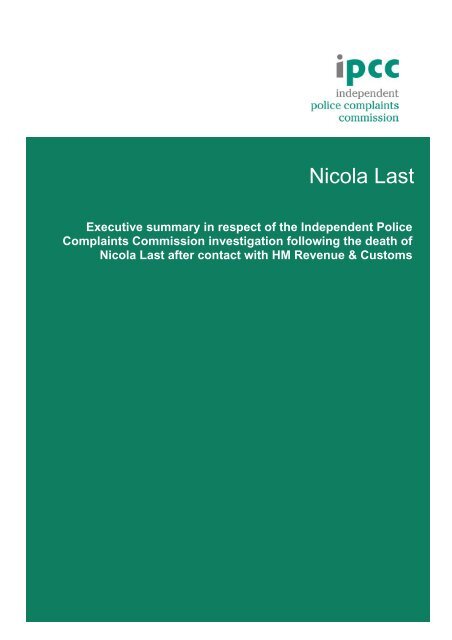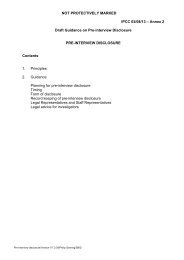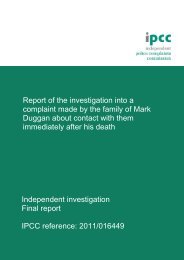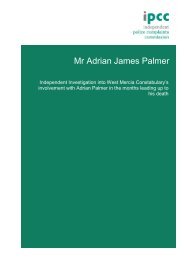Nicola Last - Independent Police Complaints Commission
Nicola Last - Independent Police Complaints Commission
Nicola Last - Independent Police Complaints Commission
You also want an ePaper? Increase the reach of your titles
YUMPU automatically turns print PDFs into web optimized ePapers that Google loves.
<strong>Nicola</strong> <strong>Last</strong>Executive summary in respect of the <strong>Independent</strong> <strong>Police</strong><strong>Complaints</strong> <strong>Commission</strong> investigation following the death of<strong>Nicola</strong> <strong>Last</strong> after contact with HM Revenue & Customs
<strong>Nicola</strong> <strong>Last</strong>Executive summary in respect of the<strong>Independent</strong> <strong>Police</strong> <strong>Complaints</strong> <strong>Commission</strong>investigation following the death of <strong>Nicola</strong><strong>Last</strong> after contact with HM Revenue &CustomsThis report deals with the circumstances of HM Revenue & Customs’contact with <strong>Nicola</strong> Jayne LAST on 15 September 2006 at Terminal 3,London Heathrow Airport. The report also considers intelligence passed bySouth Wales <strong>Police</strong> to HM Revenue & Customs in respect of <strong>Nicola</strong> LASTand her travelling companion.Summary of events<strong>Nicola</strong> LAST and Mr D travelled from London Heathrow Airport, on 7September 2006 to Port of Spain, Trinidad and Tobago.South Wales <strong>Police</strong> received and passed intelligence to HM Revenue &Customs which indicated that both <strong>Nicola</strong> LAST and Mr D had travelled toTrinidad and would each return with a quantity of cocaine.At 1030 a.m. on Friday, 15 September 2006, <strong>Nicola</strong> LAST and Mr D wereidentified and stopped by officers of HM Revenue & Customs (HMRC) ontheir arrival at Terminal 3, London Heathrow Airport. <strong>Nicola</strong> LAST and MrD were questioned in respect of their foreign travel and both had theirbaggage searched, of which nothing of interest was found.<strong>Nicola</strong> LAST and Mr D were then strip searched, to determine if they werecarrying drugs which proved negative.To establish if they had swallowed or secreted drugs internally they werethen asked to consent to an X-ray to which both agreed. X-rays werecarried out and images taken. <strong>Nicola</strong> LAST’s and Mr D’s X-ray imageswere deemed to be negative by reviewing staff.Due to nothing else being found to suggest any drug trafficking, they wereboth released at 1105 a.m. and seen to leave Terminal 3, LondonHeathrow Airport. They then returned to Barry, South Wales by NationalExpress Coach.Later that day, <strong>Nicola</strong> LAST saw her son, Joshua at their home. <strong>Nicola</strong>LAST told Joshua that she had had a good time abroad but did not tell himthat she had been to Trinidad and Tobago. At approximately 7.00 p.m.,<strong>Nicola</strong> LAST left her home to spend the evening with friends.2
<strong>Nicola</strong> <strong>Last</strong>At approximately 1.00 a.m. on Saturday 16 September 2006, whilst still ather friends’ house, <strong>Nicola</strong> LAST appeared unsteady on her feet andcomplained to them of feeling dizzy. She decided to stay at her friends’house, however, at approximately 1.30 a.m. <strong>Nicola</strong> LAST was seen to befitting and foaming at the mouth. An ambulance was called, paramedicssubsequently attended and she was taken to Llandough Hospital, Cardiff.At approximately 4.40 a.m., after becoming stable, <strong>Nicola</strong> LAST wasspoken to by a Senior House Officer regarding her condition. She wasdescribed as being quite lucid. The Senior House Officer again spoke to<strong>Nicola</strong> LAST several hours later at approximately 8.00 a.m. This time shewas described as being confused and agitated. During both conversations,<strong>Nicola</strong> LAST failed to mention that she had swallowed controlled drugs butstated that she had been on holiday to Spain. She also made mention thatshe had been drinking heavily and had been trying, on her return to controlher drinking.At approximately 8.25 a.m., <strong>Nicola</strong> LAST became unconscious and did nothave a pulse. CPR was commenced and she was then transferred to theIntensive Care Unit (ICU). Here in the ICU, <strong>Nicola</strong> LAST was stabilisedbefore going for a CT scan to her head.At this point the hospital received information from an unknown male callerwho stated that <strong>Nicola</strong> LAST had swallowed a quantity of cocaine. SouthWales <strong>Police</strong> also received similar information and this was immediatelyrelayed to the hospital. Following the CT scan, further examinations werecarried out, including both X-ray and CT scan of her abdominal area butthese also failed to identify the presence of any drugs. An ultra-sound of<strong>Nicola</strong> LAST’s abdomen then took place and was determined as abnormal.A subsequent CT scan of the abdominal area identified suspiciouspackages as well as internal bleeding and emergency surgery followed.During this surgery a total of 34 packages of drugs were recovered from<strong>Nicola</strong> LAST’s stomach along with 18 part-packages.<strong>Nicola</strong> LAST’s condition continued to deteriorate and she died at 6.40 a.m.on Sunday 17 September 2006.Subsequent analysis of the contents of the intact packages identified it tobe cocaine with an approximate total weight of 340 grams and a purity of65%. The street value of these drugs was estimated to be £52,269.Post-mortemOn 20 September 2006, a Home Office special forensic post-mortem wascarried out on <strong>Nicola</strong> LAST. This took place at the University Hospital inCardiff and was performed by Dr Stephen LEADBETTER. During the postmortemDr LEADBETTER recovered the remains of another package and3
<strong>Nicola</strong> <strong>Last</strong>a possible part-package from <strong>Nicola</strong> LAST’s stomach.No injuries were recorded and the post-mortem failed to identify the causeof death. Samples were taken to enable toxicology and histology tests tobe performed.The samples taken from <strong>Nicola</strong> LAST were subject to analysis by theForensic Science Service (FSS) who concluded that she had ingested avery large dose of cocaine prior to her death and that death from cocainepoisoning remained almost certain.South Wales <strong>Police</strong> investigation into the death of <strong>Nicola</strong> <strong>Last</strong>South Wales <strong>Police</strong> are responsible for investigating the death of <strong>Nicola</strong><strong>Last</strong> and potential drug trafficking activities of <strong>Nicola</strong> LAST and Mr D andthis report is not in relation to their investigation. Their report will be subjectof examination as part of either a criminal trial or through the Inquestprocess.In respect of Mr D, he was interviewed under caution following <strong>Nicola</strong>LAST’s death. He confirmed that he travelled to Trinidad and Tobago with<strong>Nicola</strong> LAST. He claimed that on the last night before returning home shewent off with a friend and that he did not see her again until some hourslater. He denied any knowledge of importing drugs but admitted to usingboth cannabis and cocaine whilst away and on his return to the UK.The IPCC investigationTerms of referenceThe IPCC <strong>Commission</strong>er, Gary Garland set terms of reference toinvestigate HMRC’s contact with <strong>Nicola</strong> LAST on 15 September 2006, priorto her death on 17 September 2006 with specific reference to the following:1. To investigate the actions and conduct of HMRC officers following theinterception, questioning, search and subsequent X-ray’s of <strong>Nicola</strong> LASTand her travelling companion Mr D. This will also consider any relevantintelligence available.2. To investigate the actions of South Wales <strong>Police</strong> in relation to thedissemination of intelligence in relation to <strong>Nicola</strong> LAST and Mr D to HMRC.To consider in the circumstances if such dissemination was proportionateand complete.3. To examine the actions and conduct of officers of HMRC against HMRCprocedures and policies especially in respect of the treatment of personssuspected of drug trafficking by way of internal bodily concealments, andconsider whether any disciplinary offences are disclosed.4
<strong>Nicola</strong> <strong>Last</strong>4. Consideration of any training, supervisory, management or policy issuesarising from the investigation of HMRC contact.Investigation PlanIn order to satisfy the terms of reference appropriate investigationstrategies were set in order to identify all relevant and required informationfrom both HMRC and South Wales <strong>Police</strong>. Both agencies complied withrequests for assistance and fully assisted with the investigation process. Inparticular material relating to the following key areas was specificallyobtained.South Wales <strong>Police</strong>• Information/intelligence held and passed to HMRC.• Policies and procedures relating to information/ intelligence handlingand dissemination.• Full details and accounts from appropriate staff.• Copies of material gathered in the South Wales <strong>Police</strong> criminalinvestigation.HM Revenue & Customs• Information/intelligence held along with appropriate policies andprocedures relating to information/ intelligence handling anddissemination.• Details and accounts from appropriate staff relating to HMRCidentification of <strong>Nicola</strong> LAST and Mr D, subsequent interception of<strong>Nicola</strong> LAST & Mr D and actions including search of baggage,person and X-rays.• Access to appropriate HMRC policies and procedures relating tostop and search of passengers, including passengers suspected ofimporting drugs internally, training and health and safetyrequirements.• Full details of training and of service of HMRC staff that had contactwith <strong>Nicola</strong> LAST.IPCC Investigation findingsWith regards to the agreed terms of reference, this investigation focusedon the contact that officers of HMRC had with <strong>Nicola</strong> LAST and Mr D andthe intelligence passed by South Wales <strong>Police</strong> to HMRC.The procedures and policies in place to deal with passengers such as<strong>Nicola</strong> LAST and Mr D i.e. those suspected of smuggling drugs internally,were also reviewed against the actions actually taken by officers of HMRCboth on and prior to 15 September 2006. In addition, HMRC’s response tothe intelligence was considered alongside the use of any intelligence5
<strong>Nicola</strong> <strong>Last</strong>already held.In addition this investigation also considered and reviewed thedissemination of intelligence from South Wales <strong>Police</strong> to HMRC andwhether such dissemination was proportionate and complete.As part of this investigation, all recorded and retained intelligence andinformation held by South Wales <strong>Police</strong> in respect of both <strong>Nicola</strong> LAST andMr D was identified. This involved carrying out searches of all relevantdatabases and intelligence systems to ensure that all material had beencaptured. As part of this action and where appropriate material waschecked in accordance with South Wales <strong>Police</strong> intelligence handling,management policies and procedures. Material identified as relevant wasthen viewed in order to ascertain whether more information or intelligencecould have been passed to HMRC to assist in their response to <strong>Nicola</strong>LAST and Mr D.South Wales <strong>Police</strong>On receipt of the intelligence, it is felt that South Wales <strong>Police</strong> reactedswiftly and appropriately in order to deal with a potential importation ofdrugs. The intelligence was developed and disseminated to the appropriateauthority (HMRC) in good time and in accordance with force policy. It wasalso presented in a nationally-agreed format.In respect of the importation of cocaine that took place through LondonHeathrow Airport on 15 September 2006 involving <strong>Nicola</strong> LAST andallegedly Mr D, this investigation identified that no other specificinformation or intelligence was in existence other than that passed toHMRC.HM Revenue & CustomsIn respect of the intelligence received from South Wales <strong>Police</strong>, thehandling and onward dissemination by both the HMRC receiving unit and bystaff at London Heathrow Airport were examined. It is felt that theinformation was dealt with appropriately and in accordance with agreedpolicies and procedures. As with South Wales <strong>Police</strong>, HMRC also hadinformation in their possession which, had they carried out further checks,would have revealed to them that Mr D was subject to Home Office licenceconditions.As a result of the intelligence an operational decision was made tointercept <strong>Nicola</strong> LAST and Mr D on their return to Heathrow Airport onFriday 15 September 2006.The investigation found that the HMRC staff that intercepted andsubsequently dealt with both <strong>Nicola</strong> LAST and Mr D were all considered tobe appropriately trained and experienced in this line of work. In addition the6
<strong>Nicola</strong> <strong>Last</strong>technical equipment used by HMRC staff during contact with both <strong>Nicola</strong>LAST and Mr D was found to be in good working order and was subject toregular servicing and maintenance.When HMRC staff stopped <strong>Nicola</strong> LAST and Mr D they began to questionthem. <strong>Nicola</strong> LAST and Mr D were asked for and provided their passportsand travel itineraries. <strong>Nicola</strong> LAST and Mr D stated that they had beenaway together for a one week holiday to Trinidad and had stayed in a hotel.Both confirmed that the baggage with them was their’s and that they hadpacked the bags themselves and that no one had asked them to bringanything back. After being spoken to, the baggage belonging to both <strong>Nicola</strong>LAST and Mr D was searched.Swabs were then taken of baggage, clothing and items in close contactwith skin. These swabs were then tested in a machine in order todetermine if Class A drugs (such as heroin and cocaine) were present. Inthe case of both <strong>Nicola</strong> LAST and Mr D none of the swabs taken wererecorded as positive.Following the search of their baggage, <strong>Nicola</strong> LAST and Mr D wereadvised of the officers’ wish to search their person. Each was told whattype of search was sought, in this case a strip search and the nature of thesearch. Both agreed to be searched. Both lead search officers thensought authority from a senior officer to carry out a strip search. Searcheswere authorised by an officer of appropriate rank after they were satisfiedthat reasonable grounds existed to believe that <strong>Nicola</strong> LAST and Mr D maybe in possession of drugs.The right of appeal against a strip search was explained to both <strong>Nicola</strong>LAST and Mr D and both are recorded as having had the required notice ofexplanation shown to them. This is indicated by their signatures in each oftheir respective search of person records.Following the search of <strong>Nicola</strong> LAST, the searching officer asked her if shewould consent to an X-ray examination so that she could be checked forpackages concealed internally. The officer also explained to <strong>Nicola</strong> LASTthe risks associated with concealing drugs inside her body. <strong>Nicola</strong> LASTagreed to be X-rayed.HMRC are using low dose X-ray scanners at specific key locations aroundthe country. “ConPass” body scanners are in use at London HeathrowAirport.X-rays are used in assessing whether or not suspects are concealing drugsinternally and to reduce the need for intimate searches and to minimise thelength of time that travellers are kept in custody. The scanners subject anindividual to a much-lower dose of radiation than a medical X-ray.An X-ray image was taken of <strong>Nicola</strong> LAST’s person. The image taken wasreviewed by officers and in their opinion the image did not indicate the7
<strong>Nicola</strong> <strong>Last</strong>presence of any packages within the abdominal area. An X-ray image wasalso taken of Mr D’s person. No foreign bodies were identified as beingpresent in the abdominal area.As nothing had been found on either <strong>Nicola</strong> LAST or Mr D, nor was thereanything to suggest that they had drugs concealed internally, both werefinally released from Customs’ controls at approximately 11.05 a.m.It is felt that the actions of HMRC staff at London Heathrow Airport wereappropriate and in accordance with their training and operationalprocedures. In addition there is no evidence to suggest any unlawful acts,neglect or misconduct and, therefore, neither criminal offences normisconduct issues were identified following this investigation and review ofHMRC contact with <strong>Nicola</strong> LAST and Mr D.RecommendationsAs a result of this investigation we have made recommendations to HMRCin relation to the use of their X-ray equipment and the training that staffreceive especially in the way that they both take and interpret X-rayimages. This is based on the assumption that, when <strong>Nicola</strong> LAST passedthrough Customs’ controls she was carrying the controlled drugssubsequently recovered from her, the officers examining her X-ray imagedid not detect them and the processes and systems in place also failed todetect the drugs.HMRC have been asked to review their procedures when using lowemission X-rays and in particular the two relevant recommendations are:• When using the ConPass body scanner consideration is given byofficers operating the machine to taking three X-ray images of thefront, back and side of a passenger’s abdominal area in order toprovide a more accurate view of the area and allow a more informeddecision to be taken as to whether suspect packages are present.• That training given to officers using body scans to detect drugssmuggled internally is supplemented by regular professional inputfrom a trained, clinical radiologist.ConclusionThis investigation was instigated by the death of <strong>Nicola</strong> LAST who diedafter swallowing packages of cocaine which then burst inside her. <strong>Nicola</strong>LAST and it is alleged, Mr D attempted to import cocaine from Trinidad andTobago into the United Kingdom.It is acknowledged that dealing with persons suspected of smuggling drugsinternally is a difficult area of work with unique demands on both staff andresources. This investigation and review identified that both South Wales8
<strong>Nicola</strong> <strong>Last</strong><strong>Police</strong> and HMRC dealt with <strong>Nicola</strong> LAST and Mr D appropriately andprofessionally throughout.There is no apparent evidence to suggest that <strong>Nicola</strong> LAST was forced toswallow these drugs nor was she acting under duress. It can only beassumed that she took them of her own free will and knowing the risksinvolved in so doing this. Clearly these risks were balanced againstfinancial gain with tragic results.In the course of her contact with HMRC, the ambulance service andsubsequently with healthcare professionals in Llandough Hospital, Cardiff<strong>Nicola</strong> LAST had numerous opportunities to alert people as to the situationshe was in, for reasons which we may never know she chose not to do so.Bill StoneDeputy Senior Investigator<strong>Independent</strong> <strong>Police</strong> <strong>Complaints</strong> <strong>Commission</strong>London & South East Region.27 February 20079







